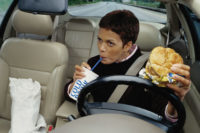A recent report shows that in just one year, more than 5,000 people were killed and nearly one-half million people were injured in crashes involving some form of distracted driving. Cell phone use is just one example of the many non-essential drive time activities that distract drivers and put everyone at risk.
By making a few simple changes in your driving routine, you can significantly improve your safety performance. Let’s take a look at the three most common types of driving distractions. They are Visual, Manual and Cognitive.
Visual Distractions require you to take your eyes off the road — even for the briefest moment. Examples include reading maps, looking down while tuning a radio or reading a text message. Visual distractions are often the worst type because all your attention leaves the road. You become totally unaware of anything taking place outside your vehicle. Another common form of visual distraction that most drivers — for that matter, safety professionals — regularly overlook: physically compensating for vehicle blind spots. Let’s examine.
Blind spots are caused when mirrors are not properly adjusted. Most vehicles on the road today can have their mirrors adjusted to eliminate blinds spots. Using both focal and peripheral vision, drivers can actually enjoy and benefit of a 360-degree view.
Unfortunately, most drivers do not have mirrors properly set up, so when they decide to change lanes, what do they do? They create a form of visual distraction by turning their heads (and many times their shoulders) to look behind them to check if they have an opening. Doing this, drivers lose sight of the road ahead, unnecessarily putting themselves in jeopardy. Any changes occurring ahead of their vehicles are now out of view, eliminating the ability to properly react; this can result in rear-end collisions or worse.
To learn how to properly adjust mirrors to eliminate these blind spots, go to Car and Driver magazine’s website and you can find helpful instructions on “How To: Adjust Your Mirrors to Avoid Blind Spots”: You’ll quickly realize that you do not have to completely take your eyes off the road ahead to complete a lane change.
Manual Distractions take one or both of your hands off the steering wheel, potentially leaving reduced or no control of your vehicle. Examples include eating or drinking, controlling the audio system, grooming or sending a text message.
How well would you be able to maneuver your vehicle to safety while holding a hot cup of coffee in one hand while trying to deal with a truck in front of you that suddenly drops some of its cargo in your path? Occurrences similar to this happen more often than you think. So why take the risk? A safe driver is in control all the time.
Cognitive Distractions take your mind off what you should be doing — staying focused on the road and your surroundings. This type of distraction prevents you from processing important, real-time information that can prevent a crash. The most common cause is cell phone use. Research has proven that even when using a hands-free device, your level of distraction remains dangerously high. Your mind is primarily focused on absorbing information from the conversation and not from your immediate surroundings.
Can you relate to the following scenario?
You go out to your vehicle; unlock the door; start the engine; drive off; and 20 minutes later, when you arrive at your destination, you can hardly recall what happened during your ride!
Has this ever happened to you?
Perhaps during this ride you were checking directions, enjoying a sandwich, using your music player, talking on the phone — all the while somehow managing to navigate through rush hour traffic.
During your drive was your mind’s eye actively focusing on traffic and road conditions or was it distracted by these other activities? This form of distracted driving is a serious safety challenge for today’s drivers and puts everyone at risk. This unwitting loss of critical information is called “inattention blindness” — a form of cognitive distraction — and studies show that it regularly occurs when drivers are engaged in phone conversations.
Studies from major universities have concluded that when you speak on a cell phone — and this includes hands-free phone calls — the inattention blindness phenomenon kicks in. Very simply, this is a person’s inability to perceive things in plain sight. Research scientists have concluded that people have a limited “attention” capacity. As a result, your mind prioritizes what it is focusing on and too often safe driving details go to the bottom of the list.
What does this mean to the average driver? Simply, get on the cell phone, get engrossed in a phone conversation, and many of the critical safety details you need to recognize and understand while driving start disappearing from your mind’s eye!
Maybe it’s a child running out into the street chasing a ball; a car that is stopped in the middle of traffic to pick up a passenger; or as simple as a traffic light turning red. Almost all of us have witnessed a driver going through a red light. Quite likely, the driver was a suffering from inattention blindness. Was that phone call so important that a driver should be willing to put everyone at risk? Unfortunately, we take our driving habits for granted and most times never give one thought to the serious consequences that may result from a seemingly harmless activity.
Remember, every time you drive and engage in a cell phone conversation, you and everyone around you are at risk. The temptation to engage in calls while driving is always present, but the decision and the responsibility to stay safe is totally yours. Make a real commitment to yourself to avoid all forms of visual and mental distractions. Stay alert. Focus on ever changing road and traffic conditions; adjust your mirrors for a 360° view; watch out for those distracted drivers; and arrive at your destination safely!



